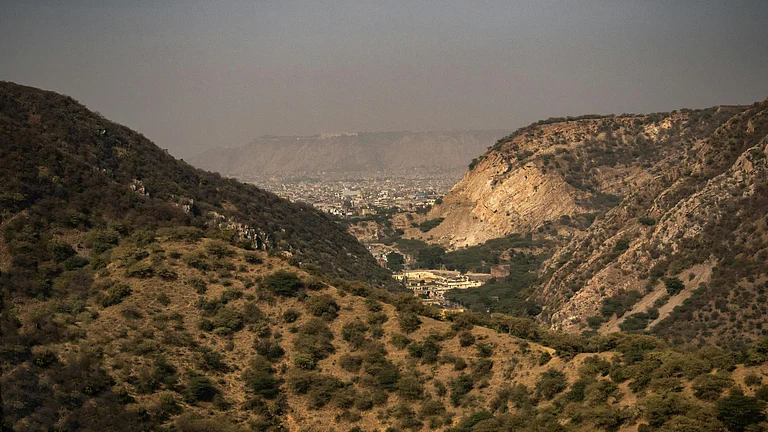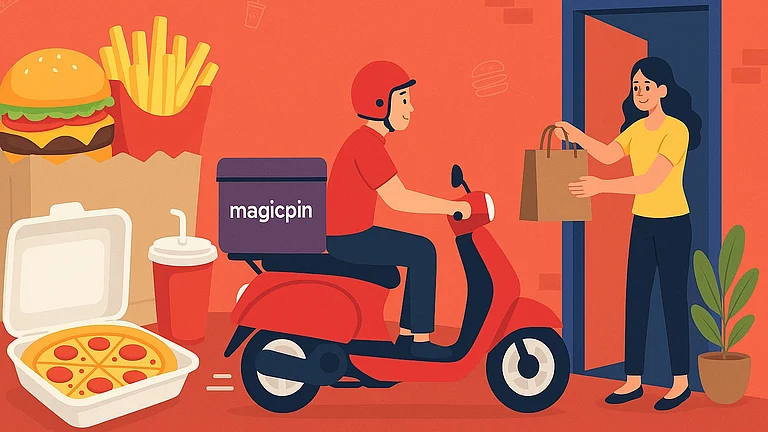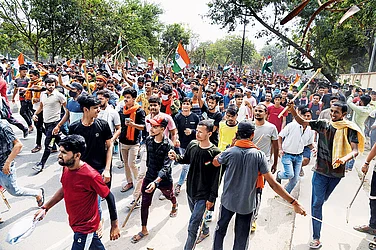For a while now, India’s neighbour Sri Lanka has been embroiled in a grave economic crisis. From adopting an impractical agrarian policy of fertiliser-free farming to depending on loans in a tourism-driven economy, a number of red flags have been spotted in the island country’s dwindling economic model.
Experts point out that the root cause of the ongoing Sri Lanka’s economic crisis is the mismanagement of finances by successive governments. In a 2019 working paper, the Asian Development Bank had said: “Sri Lanka is a classic twin deficits economy. Twin deficits signal that a country’s national expenditure exceeds its national income, and that its production of tradable goods and services is inadequate.”
With 70% of its foreign reserves depleted, Sri Lanka is now left with only $2.31 billion and a debt repayment of over $4 billion due this year. India faced a similar situation in 1991 when the country was left with just 14 days’ worth foreign exchange reserves to pay import bills. To add to that, the spike in the price of crude oil in the international market has left Sri Lanka with no fuel, leading to power cuts and long queues outside fuel stations.
The Sri Lankan crisis was exacerbated by deep tax cuts promised by President Gotabaya Rajapaksa as part of his campaign during the 2019 presidential elections. It was enacted right before the pandemic struck which further destroyed parts of its economy.
The last nail in the coffin was a switch to organic agriculture which reduced the yield, causing food shortage in the country. In India’s case, things did not get as bad in the in the 1990s as the country was self-sufficient in food production, thanks to the green revolution of the 1970s.
While India has extended a helping hand to the island country, there could be trouble brewing in its own backyard with economists and public policy experts suggesting that many Indian states have also been following a disastrous economic policy. What shields India, the experts say, is the large size of its economy and cross-subsidy from fiscally prudent states.
The Price of Populism
While India successfully dealt with a balance of payment crisis in the 1990s and subsequently became one of the world’s largest economies, some experts believe that the crisis could come back to haunt us.
In a recent meeting with Prime Minister Narendra Modi, some senior bureaucrats raised concern over populist schemes announced by several states over the last decade. Many states have a history of extending election freebies, like waiver of farm loans and past electricity bills, free televisions, scooties and mobile phones among other things, that are unsustainable.
A report by India Ratings and Research revealed that between FY17 and FY21, Punjab, Rajasthan, Andhra Pradesh and Telangana recorded high fiscal deficits in the range of 3.93% to 5.33%. Interestingly, all these states are known for doling out freebies during election campaigns. In fact, in the recently concluded state election in Punjab, the Aam Aadmi Party came to power riding on the promise of supplying 300 units of free electricity in the state. The previous government had already waived off the pending bills of 80% consumers in the state, putting a burden of Rs 1,200 crore on the exchequer.
Questioning the freebie model, former chief economic advisor Arvind Virmani argues that administratively competent governments can get re-elected through growth-enhancing policies, institutional reforms and efficient and well-targeted welfare transfers. “The incompetent ones flounder about with short-term populist measures that bankrupt them and are unlikely to get re-elected after the populist fiasco,” he says.
To meet such extravagant poll promises, states have to borrow from the market or request the Centre for relief packages. Virmani points out the issue with market borrowings: “States’ market borrowings are constitutionally limited by the Union government. States that have evaded them through PSU borrowing can still get into serious trouble.”
Some of these states have debts that cover a precarious 40% of their gross state domestic product (GSDP). In FY22, states like Punjab (53.3%), Rajasthan (39.8%), West Bengal (38.8%), Kerala (38.3%) and Andhra Pradesh (37.6%) have reported the highest debt-GSDP ratio. In FY21, the aggregate debt of states was at a 15-year high—31.3% of the GDP—a figure that is projected to stay in the same range in 2022.
Devendra Pant, chief economist, India Ratings and Research, says that the debt levels do not reflect on the interest rates of state government bonds of the better fiscally administered ones or those that are not fiscally well-administered. “The difference in the interest rates of bonds of these two kinds of states is hardly of any significance—states that are fiscally responsible are getting a pricing that is not very different from those that are not fiscally prudent. This leads to debt piling up year after year leading to debt traps,” he says.
He added that in India, a lot of the expenditure is already committed and makes up a sizeable portion of the budget, leaving little room for other expenditure. India’s fiscal policy is more revenue driven, and when the growth is good, better revenue is expected that brings the fiscal deficit under control.

The Root Cause
If there were proper income in the hands of people, the so-called populist measures would not be necessary, says professor Arun Kumar from the Institute of Social Sciences. “Income generation can be an answer to such schemes. Income can be generated by generating jobs and that mandates labour-intensive interventions rather than the capital-intensive ones. For example, earlier, big roads or infrastructure projects used to be labour-intensive with hundreds being hired. But now, with cranes and bulldozers, you just need five to 10 people,” he explains.
Over the years, states have also complained of the Centre’s attempt to usurp their areas of revenue generation, which forces them to borrow more to meet their expenditure. They say that the implementation of the goods and services tax (GST) regime has favoured the Centre in terms of revenue generation. States’ share in the Central taxes is fixed by the Finance Commission and is formula driven; grants are project specific.
The situation is not only straining the Centre-state relationship but is also putting pressure on the Centre to compensate the states by extending interest-free loans. The mounting debt level of the states also poses a threat to the borrowing capabilities of the Central government. Credit rating agencies rate India as per its creditworthiness, and these ratings become important while accessing global markets. Earlier, states had a sizeable portion of their debt as a loan from the Centre, but that has gone down significantly, forcing states to look outside.
“Generally, it is the government securities rate which affects the state development loan rates. So, if states start borrowing more and more, there will be a general pressure on interest rates to go up in the economy, which will impact the overall growth,” says Pant.
The Centre has its obligations not only towards the states but also as a sovereign. While the capital expenditure is undertaken mostly by states, the Centre also has a part of it under its name. One part of the Central government borrowing is carried out to meet its fixed obligations—the GST compensation to states and the Finance Commission grants are some of them. The 15th Finance Commission has recommended a total post-devolution revenue deficit grant of Rs 1.19 lakh crore to 17 states in 2021-22. Out of this, Rs 98,710 crore (83.33%) has been released so far.
If the Centre’s borrowings go beyond the limit, the country’s fiscal deficit target goes for a toss which then impacts its credit ratings. To tackle the issues arising in this space, the Fiscal Responsibility and Budget Management (FRBM) Bill was introduced in 2000 by the then finance minister Yashwant Sinha. The bill, which was approved by the Union cabinet in 2003, became effective from July 5, 2004, and the act has undergone several amendments since then.
Nearly two decades after its introduction, the government is yet to achieve the targets set under the act. Data shows that the Centre’s average fiscal deficit between FY15 and FY22 was 4.9%—a good 1.7% above the level mandated under the FRBM Act. Such a high level of fiscal deficit over the years has deteriorated the government’s finances. In 2022-23, the government expects to pay Rs 9.40 lakh crore in interest payments, which is 43% of its revenue receipts. In 2011-12, the interest payments accounted for 36% of the Centre’s revenue receipts. This indicates that we may not be able to sustain borrowings-led growth in the future.
Escaping Shadow of Lanka
According to Pant, the populist schemes that political parties announce are ways to redistribute income. Unlike social safety measures that are targeted and have logic, non-targeted or universal interventions—be it universal public distribution system, free power or free water for all—are economically unviable propositions. “There can always be a targeted outreach. People at the bottom of the pyramid mostly consume power up to 100 units [every month]. One can target specific groups of people and announce waivers for them. Secondly, such measures or announcements should be well within the fiscal space that the government has. If you propose to go beyond that, you must raise taxes, which states no longer have the ability to do,” expounds Pant.
Experts also point to the risks associated with the Kerala economic model that does well on social indicators, just like the Sri Lankan model did before the crisis hit, without a long-term vision for revenue generation. According to the 2021-22 revenue estimates, Kerala’s revenue grew by a robust 20.77% from 8.19% in the previous year. But during the same period, the share of pension and salary payouts in the government expenditure increased to 60.43% from 47.81% a year ago.
Kerala’s finance minister K.N. Balagopal admitted that the Sri Lankan crisis has lessons for Kerala. Sri Lanka, he said, must focus on primary sectors, like agriculture, as the country is battling a serious food shortage because of excessive dependence on hospitality and tourism. “Production of basic agricultural products is imminent in any model of economy. This is the lesson Kerala has to learn from the crisis in the island nation,” Balagopalan had recently said.
A better model would be to accelerate growth through market reform of the sectors in the state list of the constitution, suggests Virmani, including in “sectors like agriculture, irrigation, electricity distribution and production, health, education and skilling, law and order and urban governance”. He added that there should be focus on state governments’ expenditures on public goods infrastructure, such as roads, industrial estates, broadband connectivity, water and sewage systems, electricity connectivity, urban planning and development.































